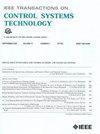下肢外骨骼的任务诊断、能量整形控制模块化框架
IF 4.9
2区 计算机科学
Q1 AUTOMATION & CONTROL SYSTEMS
引用次数: 0
摘要
各种可反向驱动的下肢外骨骼已证明其机电能力可辅助健全用户和轻度至中度步态障碍患者的自主运动,但目前还没有一种控制框架可用于任何关节,从而以可证明的稳定方式辅助日常生活中的任何活动。本文介绍了模块化多任务优化能量塑形(M-TOES)框架,该框架使用凸数据驱动优化来训练分析控制模型,从而在任何下肢外骨骼关节配置的活动中即时确定辅助关节扭矩。所提出的模块化能量基础具有足够的描述性,可以在坐立转换、楼梯上升/下降、斜坡上升/下降和不同速度的平地行走中适应正常人体关节扭矩(给定关节配置可用信号的正常反馈)。我们对模块化可背负式下肢卸载外骨骼(M-BLUE)的四种关节配置(单侧/双侧和髋关节/膝关节)的控制器进行了评估。在所有任务和受试者中,两种单侧条件明显降低了整体肌肉激活(p $\mathbf {\lt }$ 0.001)。相比之下,双侧配置的影响微乎其微,这可能与设备重量和物理限制有关。本文章由计算机程序翻译,如有差异,请以英文原文为准。
A Modular Framework for Task-Agnostic, Energy Shaping Control of Lower Limb Exoskeletons
Various backdrivable lower limb exoskeletons have demonstrated the electromechanical capability to assist volitional motions of able-bodied users and people with mild to moderate gait disorders, but there does not exist a control framework that can be deployed on any joint(s) to assist any activity of daily life in a provably stable manner. This article presents the modular, multitask optimal energy shaping (M-TOES) framework, which uses a convex, data-driven optimization to train an analytical control model to instantaneously determine assistive joint torques across activities for any lower limb exoskeleton joint configuration. The presented modular energy basis is sufficiently descriptive to fit normative human joint torques (given normative feedback from signals available to a given joint configuration) across sit-stand transitions, stair ascent/descent, ramp ascent/descent, and level walking at different speeds. We evaluated controllers for four joint configurations (unilateral/bilateral and hip/knee) of the modular backdrivable lower limb unloading exoskeleton (M-BLUE) exoskeleton on eight able-bodied users navigating a multiactivity circuit. The two unilateral conditions significantly lowered overall muscle activation across all tasks and subjects (p
$\mathbf {\lt }$
0.001). In contrast, bilateral configurations had a minimal impact, possibly attributable to device weight and physical constraints.
求助全文
通过发布文献求助,成功后即可免费获取论文全文。
去求助
来源期刊

IEEE Transactions on Control Systems Technology
工程技术-工程:电子与电气
CiteScore
10.70
自引率
2.10%
发文量
218
审稿时长
6.7 months
期刊介绍:
The IEEE Transactions on Control Systems Technology publishes high quality technical papers on technological advances in control engineering. The word technology is from the Greek technologia. The modern meaning is a scientific method to achieve a practical purpose. Control Systems Technology includes all aspects of control engineering needed to implement practical control systems, from analysis and design, through simulation and hardware. A primary purpose of the IEEE Transactions on Control Systems Technology is to have an archival publication which will bridge the gap between theory and practice. Papers are published in the IEEE Transactions on Control System Technology which disclose significant new knowledge, exploratory developments, or practical applications in all aspects of technology needed to implement control systems, from analysis and design through simulation, and hardware.
 求助内容:
求助内容: 应助结果提醒方式:
应助结果提醒方式:


